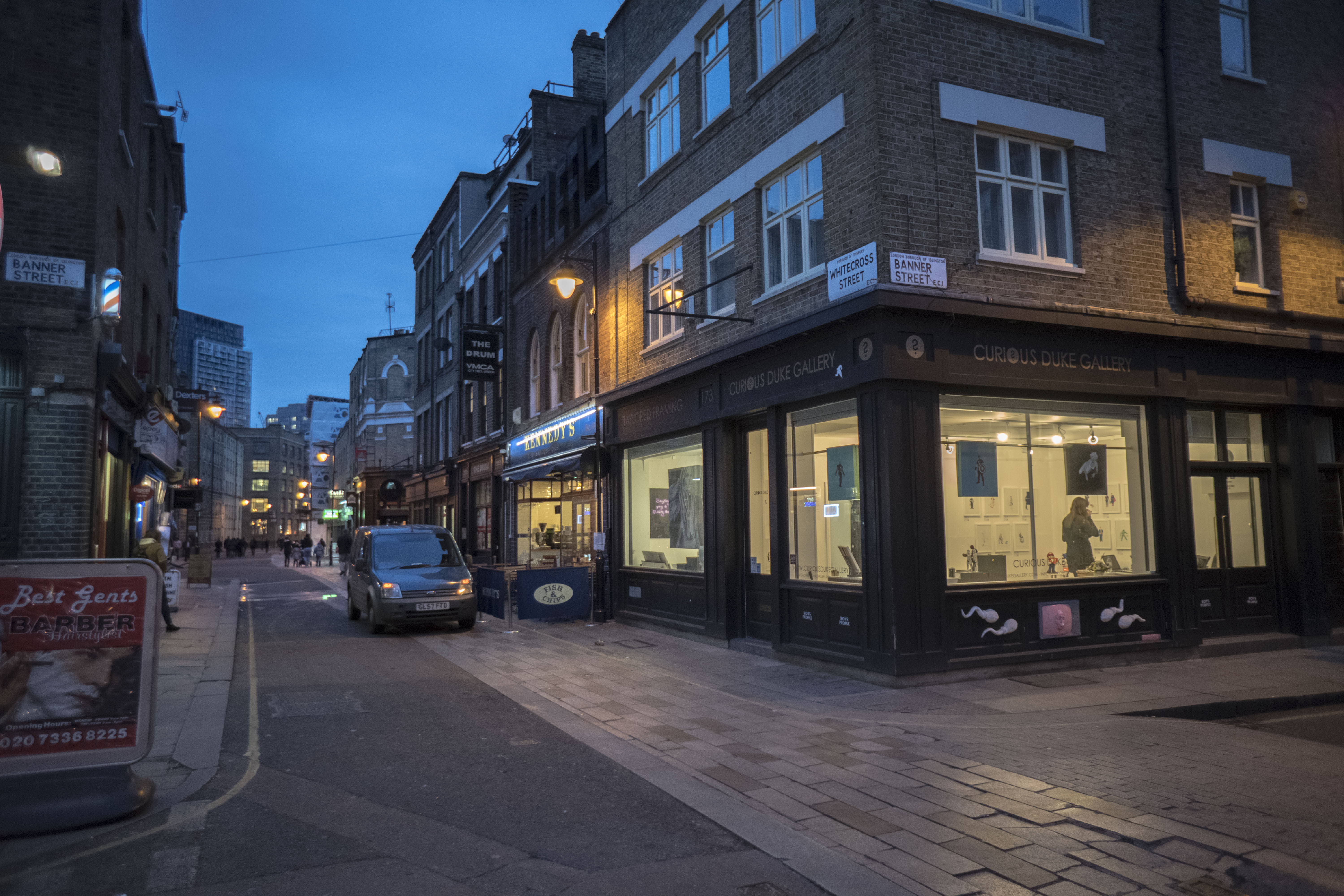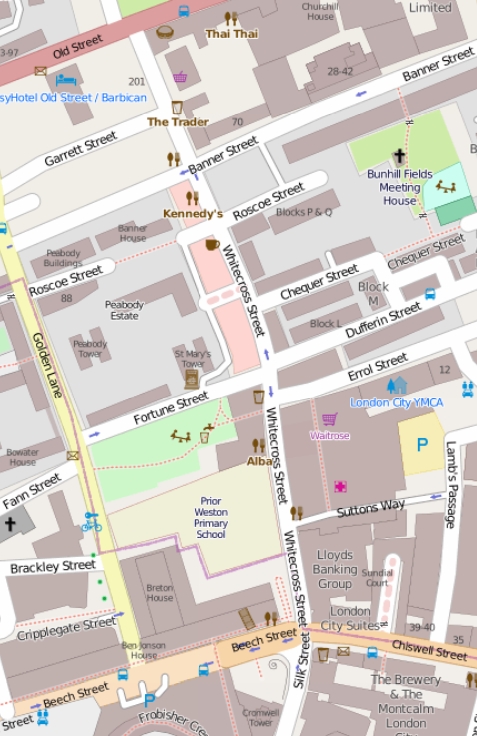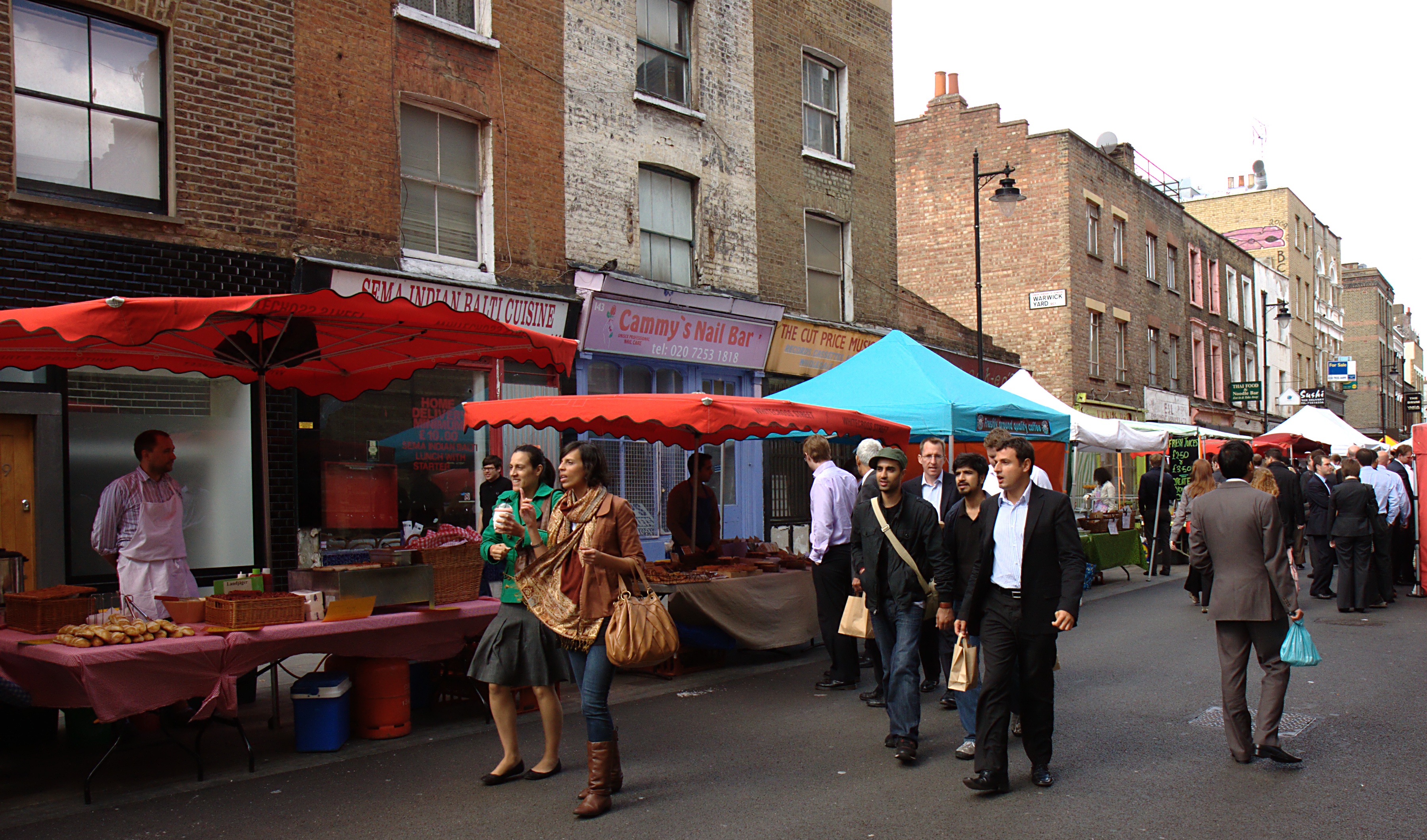Whitecross Street, London on:
[Wikipedia]
[Google]
[Amazon]
 Whitecross Street is a short street in
Whitecross Street is a short street in
 The street is located in St Luke's, Islington. It runs north–south, between
The street is located in St Luke's, Islington. It runs north–south, between
 Whitecross Street formerly continued further south from its current southern end, to just outside
Whitecross Street formerly continued further south from its current southern end, to just outside
 Whitecross Street Market, having been in existence for over 150 years, is one of London's oldest markets. The market was formerly one of London's great Sunday markets, and dates to the 17th century; although today, trading is largely limited to lunch times. During the mid-19th century, the
Whitecross Street Market, having been in existence for over 150 years, is one of London's oldest markets. The market was formerly one of London's great Sunday markets, and dates to the 17th century; although today, trading is largely limited to lunch times. During the mid-19th century, the
Whitecross Street Food Festival
' Matthew Fort, 23 June 2007, ''
 The
The
 Whitecross Street is a short street in
Whitecross Street is a short street in Islington
Islington () is a district in the north of Greater London, England, and part of the London Borough of Islington. It is a mainly residential district of Inner London, extending from Islington's High Street to Highbury Fields, encompassing the ar ...
, in Inner London
Inner London is the name for the group of London boroughs which form the interior part of Greater London and are surrounded by Outer London. With its origins in the bills of mortality, it became fixed as an area for statistics in 1847 and was u ...
. It features an eponymous street market and a large housing estate.
Since 2010, there has been an annual Whitecross Street Party one weekend in the summer, together with an exhibition of street art.
Location
 The street is located in St Luke's, Islington. It runs north–south, between
The street is located in St Luke's, Islington. It runs north–south, between Old Street
Old Street is a street in inner north-east Central London that runs west to east from Goswell Road in Clerkenwell, in the London Borough of Islington, via St Luke's and Old Street Roundabout, to the crossroads where it meets Shoreditch High ...
in the north, where it abuts St Luke Old Street, and the junction with Beech Street (west), Chiswell Street
Chiswell Street is in Islington, London, England. Historic England have seven entries for listed buildings in Chiswell Street.
Location
The street, in St Luke's, Islington, runs east-west and forms part of the B100 road. At the west end it be ...
(east) and Silk Street
Silk Street (, Xiushui Street, literally meaning "beautiful water Street"), aka Silk Market or Silk Street Market, is a shopping center in Chaoyang District, Beijing, that accommodates over 1,700 retail vendors, notorious among international to ...
(south, continuing the street) in the south. The southern junction marks the boundary with the City of London
The City of London is a city, ceremonial county and local government district that contains the historic centre and constitutes, alongside Canary Wharf, the primary central business district (CBD) of London. It constituted most of London fr ...
: Whitecross and Chiswell (north and east) are in Islington, while Beech and Silk (west and south) are in the City.
History
 Whitecross Street formerly continued further south from its current southern end, to just outside
Whitecross Street formerly continued further south from its current southern end, to just outside Cripplegate
Cripplegate was a gate in the London Wall which once enclosed the City of London.
The gate gave its name to the Cripplegate ward of the City which straddles the line of the former wall and gate, a line which continues to divide the ward into tw ...
, a gate of the London Wall
The London Wall was a defensive wall first built by the Romans around the strategically important port town of Londinium in AD 200, and is now the name of a modern street in the City of London. It has origins as an initial mound wall and di ...
surrounding the City of London
The City of London is a city, ceremonial county and local government district that contains the historic centre and constitutes, alongside Canary Wharf, the primary central business district (CBD) of London. It constituted most of London fr ...
.
In his 1720 work, ''A Survey of the Cities of London and Westminster'', John Strype
John Strype (1 November 1643 – 11 December 1737) was an English clergyman, historian and biographer from London. He became a merchant when settling in Petticoat Lane. In his twenties, he became perpetual curate of Theydon Bois, Essex and lat ...
wrote:
In Whitecross street, King Henry V. builded one fair House; and founded there a Brotherhood of St. Giles, to be kept. Which House, had sometime been an Hospital of the French Order, by the Name of St. Giles without Cripplegate, in the Reign of Edward I. The King having the Jurisdiction, and appointing a Custos thereof, for the Precinct of St. Giles, &c. Which Hospital being suppressed, the Lands were given to the Brotherhood, for the relief of the Poor. In this Street was a White cross; and near it was built an Arch of Stone, under which ran a Course of Water down to the Moor, called now Moorfields."The Fortune Playhouse, an early Elizabethan theatre, was built on the street c.1600. John Lambe was killed in 1628 at this theatre. It was closed in 1642 as part of Parliament's closure of all theatres. A debtor's prison, Whitecross Street Prison, was built on the street in 1813–15, near Fore Street (which still exists). After the prison's closure in 1870, the Midland Railway Company built a goods terminus and a booking office for goods and passengers on the site in 1876–77. In between 1876-1906 the Cripplegate Bank was located at 31 and then 1 Whitecross Street, before been incorporated into the
Union Bank of London
National Provincial Bank was a British retail bank which operated in England and Wales from 1833 until 1970 when it was merged into the National Westminster Bank. It continued to exist as a dormant non-trading company until 2016 when it was vo ...
.
The Cripplegate area was heavily damaged during World War II
World War II or the Second World War, often abbreviated as WWII or WW2, was a world war that lasted from 1939 to 1945. It involved the vast majority of the world's countries—including all of the great powers—forming two opposin ...
. When the Barbican Estate and Barbican Centre
The Barbican Centre is a performing arts centre in the Barbican Estate of the City of London and the largest of its kind in Europe. The centre hosts classical and contemporary music concerts, theatre performances, film screenings and art exhi ...
were reconstructed after the war, the section of Whitecross Street south of Silk Street was swallowed up by the new construction. The short section between Silk Street and Chiswell Street/Beech Street became part of Silk Street
Silk Street (, Xiushui Street, literally meaning "beautiful water Street"), aka Silk Market or Silk Street Market, is a shopping center in Chaoyang District, Beijing, that accommodates over 1,700 retail vendors, notorious among international to ...
. St Giles Cripplegate
St Giles-without-Cripplegate is an Anglican church in the City of London, located on Fore Street within the modern Barbican complex. When built it stood without (that is, outside) the city wall, near the Cripplegate. The church is dedicated to S ...
, mentioned by Strype, is now within the Barbican Estate.
Whitecross Street Market
 Whitecross Street Market, having been in existence for over 150 years, is one of London's oldest markets. The market was formerly one of London's great Sunday markets, and dates to the 17th century; although today, trading is largely limited to lunch times. During the mid-19th century, the
Whitecross Street Market, having been in existence for over 150 years, is one of London's oldest markets. The market was formerly one of London's great Sunday markets, and dates to the 17th century; although today, trading is largely limited to lunch times. During the mid-19th century, the street vendors
A hawker is a vendor of merchandise that can be easily transported; the term is roughly synonymous with costermonger or peddler. In most places where the term is used, a hawker sells inexpensive goods, handicrafts, or food items. Whether statio ...
and costermonger
A costermonger, coster, or costard is a street seller of fruit and vegetables in British towns. The term is derived from the words ''costard'' (a medieval variety of apple) and ''monger'' (seller), and later came to be used to describe hawkers i ...
s operating out of an informal street market in Whitecross Street came to public attention following the publication of a series of articles written by journalist, James Greenwood, and published in the ''Pall Mall Gazette.'' Greenwood's articles presented a brutal picture of the lives of London's poorest classes and caused a public sensation. By the end of the 19th century, the area had become a by-word for poverty and alcohol, and it became known as ''Squalors' Market''.
Today the market consists of stalls arranged along the northern half of the street, between Old Street and Fortune Street, with the road closed to traffic. There is a small general market and a food market of up to 50 food and drink vendors Monday–Friday lunchtime, which can be bustling with activity (and queues) on a sunny lunch time. It has occasional food festivals.Whitecross Street Food Festival
' Matthew Fort, 23 June 2007, ''
The Guardian
''The Guardian'' is a British daily newspaper. It was founded in 1821 as ''The Manchester Guardian'', and changed its name in 1959. Along with its sister papers ''The Observer'' and ''The Guardian Weekly'', ''The Guardian'' is part of the Gu ...
,'' accessed 10 Nov 2007 In recent times, there has been significant investment from Islington Council
Islington London Borough Council is the local authority for the London Borough of Islington in Greater London, England. The council was created by the London Government Act 1963 and replaced two local authorities: Finsbury Metropolitan Borough Co ...
, the City of London and English Heritage
English Heritage (officially the English Heritage Trust) is a charity that manages over 400 historic monuments, buildings and places. These include prehistoric sites, medieval castles, Roman forts and country houses.
The charity states that i ...
. It is open Monday–Friday, 10am–2pm.
Whitecross Street Prison
Whitecross Street Prison was a debtors' prison built 1813–15 to ease overcrowding atNewgate Prison
Newgate Prison was a prison at the corner of Newgate Street and Old Bailey Street just inside the City of London, England, originally at the site of Newgate, a gate in the Roman London Wall. Built in the 12th century and demolished in 1904, t ...
. It had a capacity of 400 prisoners. It closed in 1870, when all of the prisoners were transferred to the newly built Holloway Prison
HM Prison Holloway was a closed category prison for adult women and young offenders in Holloway, London, England, operated by His Majesty's Prison Service. It was the largest women's prison in western Europe, until its closure in 2016.
Hist ...
.
Other buildings
 The
The Peabody Trust
The Peabody Trust was founded in 1862 as the Peabody Donation Fund and now brands itself simply as Peabody.
, one of London's oldest and largest housing associations, has a significant estate of social housing there, the Whitecross Street Estate.
References
External links
* {{coord, 51.5229, -0.09281, type:street, display=title Streets in the London Borough of Islington